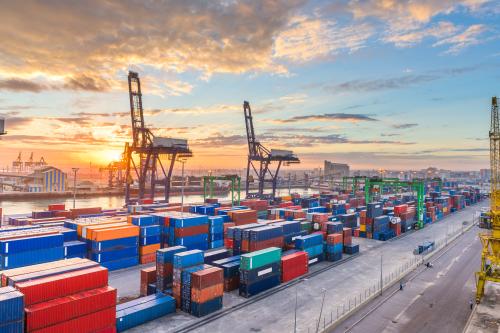On May 24, Joshua Meltzer testified before the European Parliament International Trade Committee on the impact of the Internet and data flows on economies and international trade.
Dear Chairman Lange and Members of the European Parliament. Thank you for the invitation and the opportunity to testify before you today on digital trade issues – the opportunities and challenges of the Internet and data flows for international trade, economic growth and jobs.
The ability for SMEs and businesses in developing countries to use the Internet to participate in the global economy is also very exciting. In my ten minutes I am going to outline to you how I see the impact of the internet and data flows on economies and on international trade. I will then outline the main challenges to realizing the potential of digital trade and suggest ways that the EU and the United States can show leadership in this area.
The Internet and Data Flows
Data flows underpin how the global economy works. Trade, supply chains, business operations are all enabled by the ability to move data globally. Data flows rely on the global Internet but are not limited to it. Data also flows over the industrial Internet and internal networks within companies. Data itself can be a form of trade such as when downloading software or music or when consuming services online. But data can also enable trade, such as data flows needed to use Skype or access email. McKinsey estimates that in 2014 data flows accounted for a larger share of global GDP growth than did trade in goods.
There are two main ways that the Internet is affecting international trade. One way is the impact on economies broadly, making businesses more productive and competitive domestically and in international markets.
Here, the Internet and data are enablers of economic activity that can lead to increase capacity for international trade. A key point here is that the impact of the Internet and data is economy-wide phenomena. It not only an IT sector opportunity but is affecting how all business work today. Whether manufacturing, agriculture, services, R&D, the more these sectors have Internet access and use it to conduct business, the more likely they are to be productive, pay higher wages and engage in international trade.
As Jeffrey Immelt—CEO of GE has recently stated—GE’s competitive advantage is derived from digital productivity and use of the industrial internet—not low wage manufacturing.
Secondly, the Internet is also providing businesses with access to customers who are online. In this way, Internet platforms in particular can directly enable international trade. This form of trade can be business-to-consumer as well as business-to-business. While most attention is on the former, it is actually the later— the impact of the Internet on business-to-business trade—that is most significant. In fact, B2B ecommerce is estimated at 90 percent of global $16.5 trillion ecommerce market.
The opportunities of digital trade start with the fact that the Internet is now global—approximately 3.2 billion people are online.
However, while Internet penetration in the EU and the United States is close to 90 percent, 90 percent of those without Internet access are in the developing world. This reveals a digital divide and the need for action.
Internet access is also increasingly on mobile devices.
In fact, in November last year for the first time ever there were more mobile devices than people in the world. And over half of these mobile devices are Internet-enabled.
While mobile broadband penetration was over 87 percent in the developed world, it is only 40 percent in the developing world. However this is up from 4.5 percent a mere five years ago, which is growth of almost 900 percent.
Access to the Internet on mobile devices underscores the economic importance of mobile apps.
In Europe for instance there are already 400,000 people building apps and this activity supports 1.8 million European jobs. Apps are also not only about games. There are transport apps that reduce traffic, pollution and travel time and health apps for monitoring fitness and managing health care.
For example; Dys is a French App that helps kids with dyslexia read by sending text to scientists at University Aix-Marseille who then optimize reading space; Talkforme is an Irish app that helps speech impaired users; and Angry Birds by Rovio—a Finish developer is available globally in seven languages, including Chinese, Japanese, French, German and English. It is a great game but also shown to reduce anxiety and depression.
In terms of the impact of the Internet and data on productivity, the U.S. International Trade Commission estimates that productivity gains from Internet use have increased U.S. GDP by approx. 3.5 percent. Approximately 17 percent of the increase in EU labor productivity between 2003-2010 is attributed to business engagement in e-commerce.
Productivity gains from digital commerce arise in a number of ways. One way is from access to cutting edge and often cheaper online services such as: cloud computing; professional services such as consulting, engineering, health and education; communication options such as Skype, Whats App or Google Hangouts that are often free; and access to market information online, which studies show has been key to helping businesses—in particular SMEs—to go global.
The Internet of Things is another developing industry that relies on the Internet and data flows and is estimated to be a $300 billion industry by 2017. Already, the use of Radio Frequency Identification Devices by companies such as Hewlett Packard and BMW have reduced reduces losses in transit by up to 14 percent.
As things increasingly have sensors that relay data—this will have a range of business and consumer applications from health care to robotics and driverless cars.
This leads to the importance of big data as the global Internet and the Internet of Things generates large data sets within countries, regions and globally—that when collected and analyzed is yielding new insights that increase productivity.
The opportunities here are not only for businesses but are also are having important impacts on human health and government functions. For example, analysis of tweets during Philippines Typhoon Hyan was used to direct emergency services to where they were most needed. The OECD has concluded that big data will be a key driver in the future of innovation and productivity
Finally, supply Chains would also not function without the ability to move data globally. Take Vestas, the Danish wind turbine company which collects data from globally situated turbines and analyses it in Denmark to understand the impact of temperatures, airspeeds and air pressure on turbine performance. This data is then used to identify when parts need replacing, allowing Vestas in Denmark to alert warehouses which may be located in Asia, to deliver parts to a turbine in Australia before problems arise.
All of these developments are have a particularly important impact on the ability of SMEs to engage in the international trade. Using Internet platforms SMEs can reach consumers globally.
In the US for instance, for those SMEs on eBay, 97 percent export to four or more continents compared with five percent of offline businesses. Seventy-four percent of these SMEs are still exporting after three years compared with 15 percent of offline exporters.
In the EU, only 12 percent of firms in retail are engaged in digital trade. In contrast, 93 percent of EU firms on eBay have cross-border sales and these are not only within the EU. For example, in France, 60 percent of firms on eBay sell to four continents. The Internet also gives SMEs access to online services to become more competitive.
The Internet and data flows are also affecting the composition of international trade—increasing trade in services and lower value goods. For one, the Internet allows for services to be traded online—think of professional services, medical care or education.
Digital trade is also blurring the distinction between goods and services For instance, goods such as software, music, books can be provided online.
Trade in lower value goods reflects the growing participation of SMEs in international trade. Where large companies would often export in bulk, SMEs are now trading smaller value goods – at times individual goods are being exported to customers.
To fully realize the opportunities of digital trade requires development of an enabling environment. Here, a key underpinning of digital trade will be trust in online commerce. This includes: trust that personal data provided in the course of commercial transactions is protected; trust that consumers are adequately protected from false or misleading practices; ensuring that disputes when they arise can be settled in a timely and cost-effective way; and access to secure payment mechanisms.
To realize the opportunities of Internet platforms for SMEs, there is a pressing need to address various traditional trade barriers, including: customs procedures; De minimus levels for customs duties; and access to cost effective express delivery services
And ultimately, the Internet needs to remain open and global and data needs to be able to flow freely.
This is why data localization requirements are potentially so problematic. On the one had they increase the costs of providing digital services and have the potential to leave some countries, particularly developing countries, with degraded access as companies choose to bypass these markets. Data localization can result in a balkanized Internet, where the developing world will suffer the most.
Governments such as China, Russia and India have enacted or proposed various forms of data localization laws.
Ensuring growth in digital trade also requires addressing regulatory externalities that can arise. Given the opportunities to grow trade in digital services, barriers to services trade assume even greater commercial significance. Yet the ability to move large amounts of data quickly and seamlessly across borders can bypass regulators—thereby undermining regulatory goals in areas such as privacy, health and consumer protection.
At the same time, Internet access can improve the capacity of regulators to achieve their goals—such as the ability to provide medical services to remote communities.
So we need to incentivize cross-border regulatory cooperation to manage the externalities while also maximizing the opportunities.
The United States and the EU are well situated to develop the rules and norms that will support an open and global Internet that maximizes the opportunities for economic growth, jobs and digital trade. Here, interoperability should be a focus.
This includes regulatory cooperation that builds bridges amongst regulators and regulatory approaches. The aim being to give regulators the confidence that they can achieve their goals while maximizing the economic and trade opportunities from the cross-border flow of data.
The recently finalized U.S.-EU Privacy Shield is one example of how different approaches to privacy can be bridged without unduly restricting data flows.
Interoperability is also needed in areas such as standards for the Internet of Things.
EU-US success in developing new forms of regulatory cooperation and standards development can provide global templates.
Having in place balanced IP laws is also important. In the United States, fair-use exceptions for copyright and intermediary liability protection have been key to enabling the growth in Internet companies.
Trade negotiations can be used to develop frameworks for such regulatory cooperation and to develop more specific commitments on the Internet and data flows.
The recently signed TPP provides a good example of where trade policy is going, with commitments on cross-border data flows and to avoid data localization, subject to an exceptions provision.
The TTIP and TiSA are also key ongoing negotiations where the United States and the EU can show leadership.
There is also renewed interest in the WTO across the Membership to do something more concrete on digital trade.










Commentary
TestimonyTestimony before the European Parliament, Committee on International Trade
May 25, 2016